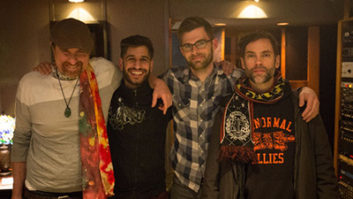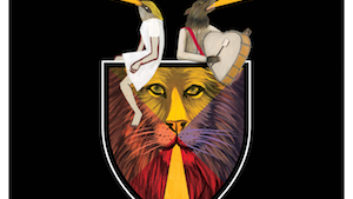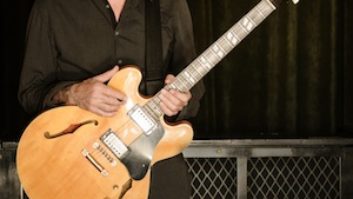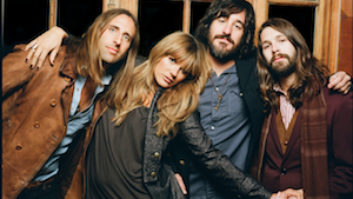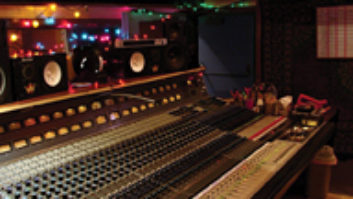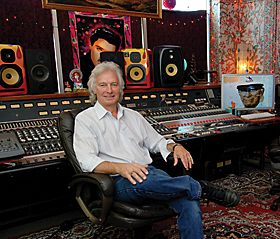
Scott at his custom Neve 8048 made in 1976. The console was originally built for RCA Recording Studios and was owned for a time by Kitaro.
Photo: Mr. Bonzai
Engineer Jim Scott may be one of the best examples of a disappearing breed. He started his career in the analog days as a gofer at Los Angeles’ Record Plant and worked his way up through the traditional tiers from janitor to assistant engineer and eventually “super-assistant.” His first gig as a fledgling solo engineer was for Sting’s The Dream of the Blue Turtles, an album that earned him a Grammy nomination for Best Engineered Album. During the past 25 years, Scott has distinguished himself with stunning work for the likes of the Red Hot Chili Peppers, Wilco, Johnny Cash, Lucinda Williams, Tom Petty and the Rolling Stones. Along the way he has continued to work with debut artists and has earned a worldwide fan club for his direct approach to making records.
Origins of an Engineer
Long before he became an engineer, Scott wanted to be a musician, asking for a guitar at age 6 and playing trumpet in the high school band. “When The Beatles arrived, I decided I wanted to play the drums,” he says. “My dad took me to a famous music store, Mel Bay Music in Kirkwood, Missouri, and we bought that blue-sparkle Ludwig set that is now here in my studio.”
All of this childhood musicianship had a major effect on Scott’s later career. “I got into some rock ‘n’ roll bands in high school, and we played at a club called Rainy Daze in St. Louis, where underage kids could perform. You learned how to put on a show and how to work with a P.A. and mics for each musician. I really grew to love that life.”
And that’s where he first got the engineering bug. “Then when I went to college, I thought I could study to be a drummer, but I discovered I wasn’t a very good one. I fell in with some other students who had a folk-rock band. They were very good musicians, but they didn’t sound good in the clubs and coffeehouses because you couldn’t hear them properly. I bought another P.A., some mics, and I engineered their shows. I didn’t think of it as a job; I just wanted my friends to sound good.
“I was studying geology at USC and having fun hanging out with the band,” Scott continues. “Then when I got out of college, I had a career in geology and became depressed. I wanted to find a job that I really enjoyed, and realized that working with the band was what I wanted to do.”
At that point, Scott began pursuing his dream. “I had a friend who worked at the Record Plant recording studio as a temporary bookkeeper and she said that kids come in and intern, and they learn how to engineer, record and make records. I was 28 years old and was hired to be a gofer — with a college degree and six years as a professional geologist. Then I became the nighttime guy who answered the phone. Then I moved up to being a janitor, and along the way I was actually trained to do what you need to do in a recording studio.”
Scott’s training at the Record Plant paved the way for his first recording job. “Then I got to work in the remote recording trucks for a couple of years,” he says. “MTV had just begun in 1981 and every band in the country needed a video immediately. The quickest way to get one was to film the gig. We worked and worked all over the country.
“I met my wife and decided to quit the road life and get married. I was back in the studio [Record Plant L.A.] as the top assistant engineer. Finally, I needed more money and I went in to get it and [Record Plant co-founder] Chris Stone wouldn’t give it to me. I wanted 25 cents more an hour, but he said $5 an hour was the top for an assistant. I said I needed more money and just quit. He said, ‘Great. Now you are a recording engineer and you can go out and bring me a client. Congratulations.’
“I was unemployed for a while, did some demo work for friends,” Scott continues. “But studios were expensive. I didn’t have any money, and the Record Plant called me because they had a job called the super-assistant. You got paid double — $10 an hour — if you would come back to help out on complicated jobs when the client wasn’t happy with the staff guys.”
A turning point came when Scott was called back as a super-assistant for a session with Sting and an English engineer, Pete Smith. “We were doing a mix of The Police’s Synchronicity tour for cinema release,” he recalls. “The English engineer was not hip to that technology. He just wanted to be a rock ‘n’ roll mixer. I knew how to run a session, and figured it all out with the studio tech team and everyone was happy.
“Six months later, I got a call from Pete Smith. He asked me if I wanted to come down to Barbados and engineer Sting’s [1985] solo album, The Dream of the Blue Turtles. Remember, Pete had never produced a record and I had never engineered a record. We made the record and I was nominated for a Grammy for Best Engineered Album.”
A New Home: Plyrz Studios
After 20-plus successful years of recording at studios in L.A. and around the world, Scott decided to build his own mammoth workshop, Plyrz Studios.
“I created the studio because Cello Studios, one of my favorite studios for many years, closed down,” he explains. “I became studio-homeless, and although I continued working at other favorites like The Village, Sunset Sound and Sound City, I still had to continually move the equipment in and out. I continued decorating my workplaces and doing the gigs, but at 4 o’clock in the morning I had to pack it all up. The logistics of moving everything around just to do an honest day’s work got so tedious that I decided to build my own studio and stop commuting.”
His new studio is far removed from the Hollywood studio scene, nestled among small businesses and manufacturers in an industrial park. “I picked out a brand-new building with lots of totally clean power,” he says. “It’s a giant space with 26-foot ceilings and it’s up on a hill with a beautiful view. It’s plenty big enough for all of my equipment; I was able to buy the equipment that I had always wanted and worshipped — the kind of vintage equipment I have been using to make my living for the last 20 years.”
Scott’s pride and joy in the control room is a rare desk. “It’s a Neve 8048 and the serial number is A3716, which dates it to 1976. It was commissioned and custom-built like all the Neve consoles of that era, when it took at least six months to make a console. This one was built for RCA Recording Studios in New York City and was installed in 1976. It stayed there until 1995, when it was bought by a wonderful Japanese musician named Kitaro for his private studio in Wade, Colorado. It is absolutely stunning and I consider it perhaps Smithsonian quality.”
The list goes on: “I have the two Neve sidecars, BCM-10s. One of them has 1073 equalizers; the other sidecar has 1079 equalizers, which are very similar with just a slightly different color. Those pieces of gear are the most valuable and the most charming pieces I have for the recordings.”
Scott’s other most important items are his four UREI 1176 compressors. “They are very popular and have been the sound of rock ‘n’ roll since they were introduced in the late ’60s. I also have two United Audio 175 tube compressors, which are sort of the precursor to the solid-state 1176. I rely on them for the rock ‘n’ roll compression that people admire.” Plyrz also features a large collection of vintage musical instruments.
Alterations within the big rooms called for some acoustic design to suit Scott’s recording styles. “It started as a big warehouse and now there are rooms within rooms within rooms. I put in a drop ceiling for the main recording space and then built a nice iso room within that area. I also built an amp closet with cubbyholes for a variety of guitar amps or Leslies, or anything that would be loud enough to pollute another sound and would work best if it has its own smaller room.”
Scott’s mic collection is impressive. “I really don’t have enough money to compete with the great recording studio collections, but I have a nice collection, including Neumann U87s, U47s, and RCA 44s and RCA 77s. And I have a big box of common rock ‘n’ roll mics, like Sennheiser, Shure, AKG and others. If I need one of the really fine vintage mics that I don’t own, we just rent them.”
Another advantage of having your own studio is that you can maintain a consistent monitoring environment. “Since 2003, I have been a big fan of the KRK E8T speakers,” he says. “I have three sets of those, and I rotate the ones I use for stereo so they don’t get tired and I can also use them for 5.1 mixing. I also have a set of ProAcs that I have used for a long time.”
Tracking and Mixing
Scott describes how he tracks the artists and bands he typically works with: “Over the past 10 or 15 years, I have done a lot of singer/songwriter-type rock ‘n’ roll bands. I try to get as many people together performing the song well at the same time to create the best possible take from the most people playing the music.”
Many engineers wait until the mixing phase of a project before dialing in the processing changes essential to a finished product, but not Scott. “My goal is that when the band walks in for the first playback or the first song, they say, ‘Wow, this sounds like a record.’
“If you lose the artist at any point along the way, you are going to have to struggle to get them back because they are the ones whose reputation is on the line. They want to come in to the control room and hear something that’s just fantastic. That is their goal for the day’s work. If what they hear is great, they are happy, they are excited, their problems are solved and then they can just play their music.”
It’s no surprise that the processing-on-the-go lends itself to an easy transition to the mix. “It is easier for me to mix the stuff I have recorded. By the time it is ready to mix, it is really ready to mix: There are no loose ends, no noises, nothing needs to be cleaned up or fixed. With any luck, I have been able to record tracks that sound good together.”
For projects recorded by other engineers, Scott takes a different approach. “When the material comes to me from an outside source, the first thing I do is listen to each sound source — just to know it is what it says it is, and that it sounds like a pure tone, not broken or distorted for some mechanical reason. I just want to hear what the guy is calling his bass DI sound or his acoustic piano sound. I just quickly take inventory to know that everything is working and this is what I am up against today.
“Then I usually start with the drums and bass — but as quickly as I can, I like to get the music up, sounding like some kind of music before I dig too deep. They didn’t record their album thinking about what it would sound like when I was going to mix it. They recorded it thinking that it sounded good when they did it. You gotta bow down to that philosophy, and say, ‘They had something. What is it?’
“There is a natural balance in there somewhere. I might not like the drum sound, but that’s okay. Maybe the drum sound goes with the bass sound. Maybe the drum sound goes with the piano sound. Maybe it all goes together as a sound. You have to figure that out.”
At Plyrz Studios, recording is done mostly to Pro Tools. “Honestly, in the last three years we had two projects come on tape. One was Wilco, and that was on multitrack for Sky Blue Sky. I was the mixer and we played back off multitrack and mixed down to half-inch. It just sounded great.”
Current Projects
Now that Scott has his own studio, the pace has not slowed in the least. “I am doing a record with a young band called the Sons of Bill, sort of a country-rock band from Virginia,” he comments. “I am also in the middle a project with Citizen Cope — that’s Clarence Greenwood. I recently finished my fourth album with my good friends Lowen & Navarro, Learning to Fall.
“And after that I am going to New Zealand for a project,” he adds. “I was invited by Neil Finn of Crowded House to work with his organization called Seven Worlds Collide. A few years ago, he invited a great bunch of musicians, singers, songwriters to make an album of original music and live performances for DVD as a benefit for Oxfam. This year, I have been invited to co-produce and engineer, with Neil and his brother, Tim, and his sons, Liam and Elroy. Wilco is joining us, and three or four members of Radiohead, Johnny Marr, Lisa Germano and Sebastian Steinberg from Soul Coughing. We have a song from Eddie Vedder and hopefully one from Tom Petty. The goal is to make an album of new and original music, putting together different combinations of the musicians gathered there. Everyone is donating their time, and it’s a way in which I can give something back to rock ‘n’ roll, which has been very good to me.”
When asked for an explanation of how he achieved his successes, Scott offers this advice: “Every day you go to work, you have to do your best work. If you slack off or get a bad attitude, the artist or producer will remember that and call somebody else the next time. That’s my hot business tip of the day — be great.”
For more from Mr. Bonzai’s interview with Jim Scott, including favorite session moments with Tom Petty, Wilco, Roy Orbison, the Rolling Stones and other top artists, visitmixonline.com.
